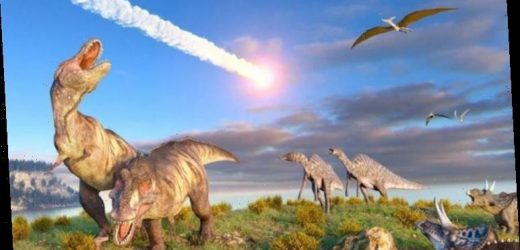Asteroid: Animation shows how dinosaurs were ‘wiped out’
When you subscribe we will use the information you provide to send you these newsletters.Sometimes they’ll include recommendations for other related newsletters or services we offer.Our Privacy Notice explains more about how we use your data, and your rights.You can unsubscribe at any time.
About 66 million years ago, the dinosaurs’ dominance on Earth was cut short when a major body from space came crashing into our planet. The object is believed to be about 10-miles (16 kilometres) wide and left a crater across the coast of Mexico which runs 63 miles wide and 12 miles deep. The impact wiped out a vast majority of dinosaurs, while an ensuing climate shift which lasted thousands of years led to the demise of three-quarters of all life on Earth.
Where this major space rock came from has been a mystery, but Harvard University scientists believe they now have the answer.
When most think of the major space rock, they state it was an asteroid.
However, new research has claimed the body was more likely a comet which swung in from the edge of the solar system in a region known as the Oort Cloud – where billions of comets, as well as dust and debris still resides – which circles the entire solar system.
The main difference between an asteroid and a comet is the former is made up of metals and rocks, while the latter is more composed of ice, dust and rock.
This means it is easier for a comet to break up, especially as it passes by the Sun.
The new research from the Center for Astrophysics at Harvard & Smithsonian has suggested a comet was likely pulled in from the Oort Cloud and passed through the solar system.
As the comet got close to the Sun – comets which do so are known as ‘sungrazers’ – it likely broke up, with the chunks of the comet taking on different directions.
Unfortunately for Earth and the dinosaurs, the larger chunk of the comet ended up on a collision course with the planet after a game of tug-of-war between the Sun and Jupiter, the largest planet in the solar system.
Harvard University astrophysics undergraduate student Amir Siraj said: “The solar system acts as a kind of pinball machine.
“Jupiter, the most massive planet, kicks incoming long-period comets into orbits that bring them very close to the Sun.
“In a sungrazing event, the portion of the comet closer to the sun feels a stronger gravitational pull than the part that is further, resulting in a tidal force across the object.
“You can get what’s called a tidal disruption event, in which a large comet breaks up into many smaller pieces.
“And crucially, on the journey back to the Oort Cloud, there’s an enhanced probability that one of these fragments hit the Earth.”
DON’T MISS
Dinosaur discovery: T-Rex fossil finds reveals tyrannosaurs’ earl life
Spinosaurus lived like a heron – ‘Bizarre by dinosaur standards’
Dinosaur discovery: Found fossils may be largest land animal
What adds more weight to the Oort Cloud theory is that rock traces found in the crater site suggest the comet was made of carbonaceous chondrite.
Carbonaceous chondrite is rare in objects from the asteroid belt – located between the orbits of Jupiter and Mars – but could be widespread in objects from the Oort Cloud, according to Mr Siraj and Harvard’s Avi Loeb.
Professor Loeb said: “I hope that we can test the theory by having more data on long-period comets, get better statistics, and perhaps see evidence for some fragments.”
The Harvard astronomy professor said not only could the new study solve a long-standing theory, but it could help protect Earth from similar disasters.
He said: “It must have been an amazing sight, but we don’t want to see that again.”
Source: Read Full Article






